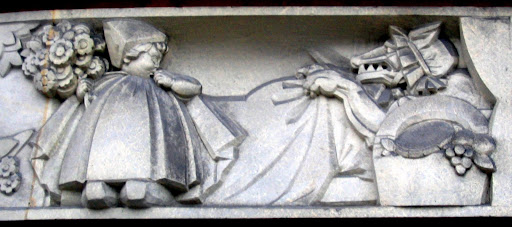Ninomiya Kinjiro (Sontoku) at the door of
Kyoto Municipal Museum School History
Stone sculptures like this were not uncommon in or in front of Japanese schools, especially elementary schools during 1930s and 1940s. Typically these statues portray Ninomiya Kinjiro (Ninomiya Sontoku) (1787-1856), showing him as a boy reading a book while walking and carrying firewood on his back. Ninomiya was self-taught and didn’t attend school, as in his lifetime there were no schools for children of farmers, but he unusually rose into the Samurai class later in life from his peasant origins (see biography below). With the introduction of a national education system in 1872 in Japan, he became a symbol and a model for school children of virtues such as diligence, obedience, dignity, and honesty. Ninomiya is represented reading and studying in every spare moment at work.
A song celebrating the life of ‘Ninomiya Kinjiro’ was introduced by the Ministry of Education as a compulsory feature of the elementary school curriculum in 1911 (Meiji era, year 44), for children of Year 2 (age 7). This was to instil moral sense and moral attitude of children and was later reinforced by the introduction of Ninomiya’s statutes into elementary schools. These qualities also fed into the cultivation of military discipline during the Second World War.
After the Second World War most of Ninomiya’s statues were removed as an obstacle to democratic education, but in the 1960s in some primary schools Ninomiya’s statue reappeared in bronze, together with other classic sculptures such as Rodin’s Le Penseur in bronze, sometimes with school mottos represented by statues. Often they were donated by successful graduates and their function could be described as a kind of hidden curriculum.
In my childhood in the late 1950s, Ninomiya’s song was used by girls informally as a ‘rubber ball-play with song’ (Temari uta). But now most Japanese, except for the generation over sixty, know neither the song nor the game, although Ninomiya’s name and reputation might be familiar to adults.
One such statue was taken to the USA as war loot by a naval officer after the Battle of Okinawa in 1946 and presented to Rollins College, a small private liberal arts college in Winter Park, Florida, where the President promised to keep the statue in the main lobby of the college's administration building forever. So this potent image from one culture was adopted by an educational institution in a distant country; such was its effect that 50 years later a request by Okinawa Prefecture for its return was initially refused, but finally conceded on the offer of a replica so that the original now stands in front of Shogaku Junior and Senior High School in Okinawa.
In response to concern about moral attitudes of young Japanese in the present day, sculptures of Ninomiya in bronze or gold are sometimes donated by local community leaders of an older generation to stand in public places such as stations and crossroads
Questions we might ask:
What impact did this image have on students, teachers and the community?
How should we understand its pedagogic and decorative functions?
What equivalent images and symbols are found in other countries and cultures?
More images of Ninomiya Sontoku shrines and sculptures can be found at:
http://ja.wikipedia.org/wiki/%E4%BA%8C%E5%AE%AE%E5%B0%8A%E5%BE%B3
http://homepage3.nifty.com/koyaji/me/nink/nink.htm
A modern example stands in a public space in the Little Tokyo district of Los Angeles:
http://www.themarkeworld.com/2010/11/ninomiya-kinjiro/
Ninomiya Kinjiro (Ninomiya Sontoku, 1787-1856) (the ‘peasant sage’) was a prominent 19th century Japanese agricultural leader born to a peasant family who became a great landowner and public administrator. Poor, and orphaned at age 16, he was self-educated whilst working in agriculture. He underwent severe hardship in his youth, suffering the loss of the family farmlands to flood. But by the age of 24 he had revived his family's fortunes, and at 36 was commissioned by his domain lord to aid in the restoration of a family fiefdom (now Ninomiya Village, Tochigi Prefecture). He prevailed at this task for ten years, thereafter widely sought for advice on regional administration, development and economic management. At age 57 he was raised to the position of attendant to the Tokugawa shogun family, a great honour for someone of his lowly origin. He was awarded posthumous honours by the emperor.
The name Sontoku was given to him for his accomplishment. His success as an administrator led to his being entrusted with one of Shogunate's estate, which was He developed a philosophy from his own experience and from strands of Buddhism, Shintoism and Confucianism, in which he saw agriculture as the highest form of human activity (this was put into written form by others). Ninomiya was a moral leader who believed in the value of hard work and the dignity of manual labour and was able to instil in peasants pride in their own occupations and the urge to follow his example of working to improve general welfare. In the long run his ideas may have helped spur a desire for a more egalitarian social order.
Sontoku died in 1856 at the age of seventy. In the Meiji era, shrines were established across Japan to worship his spirit. Shinto shrines called Hōtoku Ninomiya Jinja were built in 1894 in Odawara City, Kanagawa Prefecture, and in 1897 in Imaichi City, Tochigi Prefecture as the first prefectural shrines dedicated to Sontoku's memory. Later, more than ten others were established from Hokkaido to Okinawa. In Japan, he is still a symbol of hard work and perseverance.
A head and shoulders portrait of Ninomiya Sontoku as an adult appeared on the obverse of a 1 Yen bank note issued March, 1946 (Showa era, year 21) by Bank of Japan (NIPPON GINKO)
http://www2m.biglobe.ne.jp/%257eZenTech/money/banknote/en_p11_japan.htm
Further information on the life of Ninomiya can be found at:
http://en.wikipedia.org/wiki/Ninomiya_Sontoku
http://eos.kokugakuin.ac.jp/modules/xwords/entry.php?entryID=523
Yoko Yamasaki
Mukogawa Women’s University



